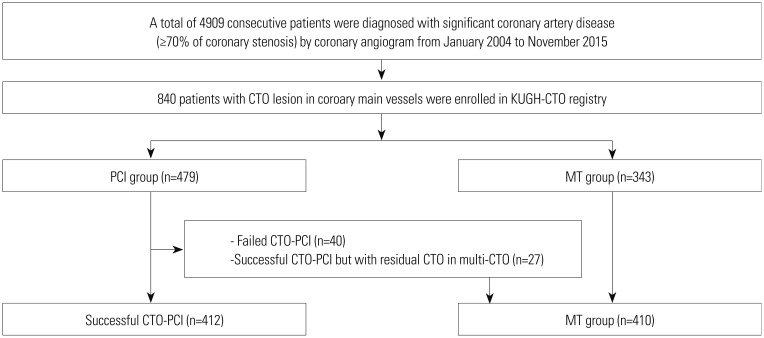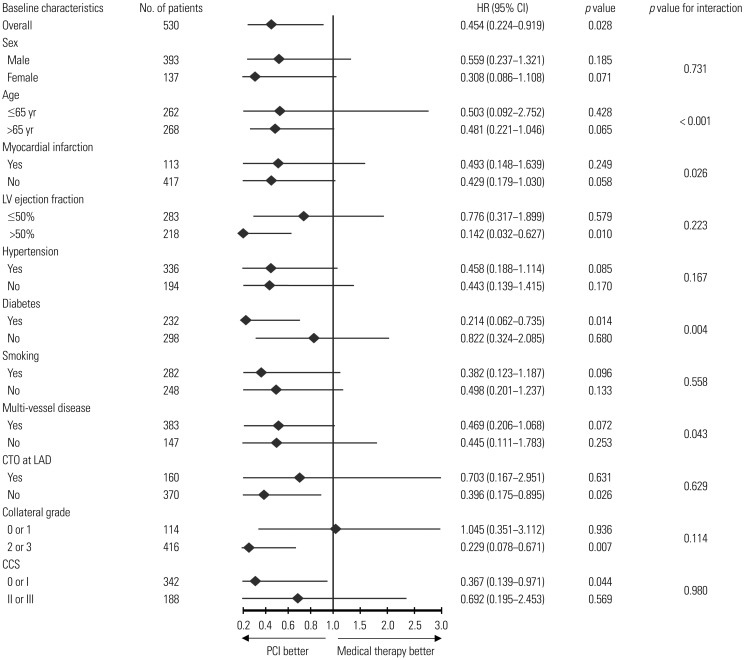Yonsei Med J.
2018 Jul;59(5):602-610. 10.3349/ymj.2018.59.5.602.
Five-Year Outcomes of Successful Percutaneous Coronary Intervention with Drug-Eluting Stents versus Medical Therapy for Chronic Total Occlusions
- Affiliations
-
- 1Cardiovascular Center, Korea University Guro Hospital, Seoul, Korea. swrha617@yahoo.co.kr
- 2Research Institute of Health Sciences, Korea University College of Health Science, Seoul, Korea.
- 3Department of Thoracic and Cardiovascular Surgery, Korea University Guro Hospital, Seoul, Korea.
- 4Department of Medicine, The Second Affiliated Hospital of Kunming Medical University, Kunming, China.
- 5Department of Medicine, Korea University Graduate School, Seoul, Korea.
- KMID: 2412651
- DOI: http://doi.org/10.3349/ymj.2018.59.5.602
Abstract
- PURPOSE
Many recent studies have reported that successful percutaneous coronary intervention (PCI) with drug-eluting stents (DESs) for chronic total occlusion (CTO) has more beneficial effects than failed CTO-PCI; however, there are only limited data available from comparisons of successful CTO-PCI with medical therapy (MT) in the Korean population.
MATERIALS AND METHODS
A total of 840 consecutive CTO patients who underwent diagnostic coronary angiography, receiving either PCI with DESs or MT, were enrolled. Patients were divided into two groups according to the treatment assigned. To adjust for potential confounders, propensity score matching (PSM) analysis was performed using logistic regression. Individual major clinical outcomes and major adverse cardiac events, a composite of total death, myocardial infarction (MI), stroke, and revascularization, were compared between the two groups up to 5 years.
RESULTS
After PSM, two propensity-matched groups (265 pairs, n=530) were generated, and the baseline characteristics were balanced. Although the PCI group showed a higher incidence of target lesion and vessel revascularization on CTO, the incidence of MI tended to be lower [hazard ratio (HR): 0.339, 95% confidence interval (CI): 0.110 to 1.043, p=0.059] and the composite of total death or MI was lower (HR: 0.454, 95% CI: 0.224 to 0.919, p=0.028), compared with the MT group up to 5 years.
CONCLUSION
In this study, successful CTO PCI with DESs was associated with a higher risk of repeat PCI for the target vessel, but showed a reduced incidence of death or MI.
Keyword
MeSH Terms
Figure
Reference
-
1. Takagi K, Ielasi A, Chieffo A, Basavarajaiah S, Latib A, Montorfano M, et al. Impact of residual chronic total occlusion of right coronary artery on the long-term outcome in patients treated for unprotected left main disease: the Milan and New-Tokyo registry. Circ Cardiovasc Interv. 2013; 6:154–160. PMID: 23572491.2. Claessen BE, Dangas GD, Weisz G, Witzenbichler B, Guagliumi G, Möckel M, et al. Prognostic impact of a chronic total occlusion in a non-infarct-related artery in patients with ST-segment elevation myocardial infarction: 3-year results from the HORIZONS-AMI trial. Eur Heart J. 2012; 33:768–775. PMID: 22240495.
Article3. Gierlotka M, Tajstra M, Gąsior M, Hawranek M, Osadnik T, Wilczek K, et al. Impact of chronic total occlusion artery on 12-month mortality in patients with non-ST-segment elevation myocardial infarction treated by percutaneous coronary intervention (from the PL-ACS Registry). Int J Cardiol. 2013; 168:250–254. PMID: 23058348.
Article4. Claessen BE, Hoebers LP, van der Schaaf RJ, Kikkert WJ, Engstrom AE, Vis MM, et al. Prevalence and impact of a chronic total occlusion in a non-infarct-related artery on long-term mortality in diabetic patients with ST elevation myocardial infarction. Heart. 2010; 96:1968–1972. PMID: 20930044.
Article5. Claessen BE, van der Schaaf RJ, Verouden NJ, Stegenga NK, Engstrom AE, Sjauw KD, et al. Evaluation of the effect of a concurrent chronic total occlusion on long-term mortality and left ventricular function in patients after primary percutaneous coronary intervention. JACC Cardiovasc Interv. 2009; 2:1128–1134. PMID: 19926056.
Article6. Bataille Y, Déry JP, Larose E, Déry U, Costerousse O, Rodés-Cabau J, et al. Prevalence, predictors and clinical impact of unique and multiple chronic total occlusion in non-infarct-related artery in patients presenting with ST-elevation myocardial infarction. Heart. 2012; 98:1732–1737. PMID: 23014480.
Article7. Opolski MP, Ó Hartaigh B, Berman DS, Budoff MJ, Achenbach S, Al-Mallah M, et al. Current trends in patients with chronic total occlusions undergoing coronary CT angiography. Heart. 2015; 101:1212–1218. PMID: 26076936.
Article8. Brindis RG, Fitzgerald S, Anderson HV, Shaw RE, Weintraub WS, Williams JF. The American College of Cardiology-National Cardiovascular Data Registry (ACC-NCDR): building a national clinical data repository. J Am Coll Cardiol. 2001; 37:2240–2245. PMID: 11419906.
Article9. Grantham JA, Marso SP, Spertus J, House J, Holmes DR Jr, Rutherford BD. Chronic total occlusion angioplasty in the United States. JACC Cardiovasc Interv. 2009; 2:479–486. PMID: 19539249.
Article10. Werner GS, Surber R, Kuethe F, Emig U, Schwarz G, Bahrmann P, et al. Collaterals and the recovery of left ventricular function after recanalization of a chronic total coronary occlusion. Am Heart J. 2005; 149:129–137. PMID: 15660044.
Article11. Joyal D, Afilalo J, Rinfret S. Effectiveness of recanalization of chronic total occlusions: a systematic review and meta-analysis. Am Heart J. 2010; 160:179–187. PMID: 20598990.
Article12. Valenti R, Marrani M, Cantini G, Migliorini A, Carrabba N, Vergara R, et al. Impact of chronic total occlusion revascularization in patients with acute myocardial infarction treated by primary percutaneous coronary intervention. Am J Cardiol. 2014; 114:1794–1800. PMID: 25438904.
Article13. George S, Cockburn J, Clayton TC, Ludman P, Cotton J, Spratt J, et al. Long-term follow-up of elective chronic total coronary occlusion angioplasty: analysis from the U.K. Central Cardiac Audit Database. J Am Coll Cardiol. 2014; 64:235–243. PMID: 25034057.14. Mehran R, Claessen BE, Godino C, Dangas GD, Obunai K, Kanwal S, et al. Long-term outcome of percutaneous coronary intervention for chronic total occlusions. JACC Cardiovasc Interv. 2011; 4:952–961. PMID: 21939934.
Article15. Valenti R, Migliorini A, Signorini U, Vergara R, Parodi G, Carrabba N, et al. Impact of complete revascularization with percutaneous coronary intervention on survival in patients with at least one chronic total occlusion. Eur Heart J. 2008; 29:2336–2342. PMID: 18682446.
Article16. Hoye A, van Domburg RT, Sonnenschein K, Serruys PW. Percutaneous coronary intervention for chronic total occlusions: the Thoraxcenter experience 1992–2002. Eur Heart J. 2005; 26:2630–2636. PMID: 16183693.
Article17. Choi SY, Choi BG, Rha SW, Baek MJ, Ryu YG, Park Y, et al. Percutaneous coronary intervention versus optimal medical therapy for chronic total coronary occlusion with well-developed collaterals. J Am Heart Assoc. 2017; 6:e006357. PMID: 28903939.
Article18. Kim BK, Shin S, Shin DH, Hong MK, Gwon HC, Kim HS, et al. Clinical outcome of successful percutaneous coronary intervention for chronic total occlusion: results from the multicenter Korean Chronic Total Occlusion (K-CTO) registry. J Invasive Cardiol. 2014; 26:255–259. PMID: 24907081.19. Hannan EL, Zhong Y, Jacobs AK, Stamato NJ, Berger PB, Walford G, et al. Patients with chronic total occlusions undergoing percutaneous coronary interventions: characteristics, success, and outcomes. Circ Cardiovasc Interv. 2016; 9:e003586. PMID: 27162216.
Article20. Prasad A, Rihal CS, Lennon RJ, Wiste HJ, Singh M, Holmes DR Jr. Trends in outcomes after percutaneous coronary intervention for chronic total occlusions: a 25-year experience from the Mayo Clinic. J Am Coll Cardiol. 2007; 49:1611–1618. PMID: 17433951.21. Shah PB. Management of coronary chronic total occlusion. Circulation. 2011; 123:1780–1784. PMID: 21518991.
Article22. Morino Y, Kimura T, Hayashi Y, Muramatsu T, Ochiai M, Noguchi Y, et al. In-hospital outcomes of contemporary percutaneous coronary intervention in patients with chronic total occlusion insights from the J-CTO Registry (Multicenter CTO Registry in Japan). JACC Cardiovasc Interv. 2010; 3:143–151. PMID: 20170870.23. Patel VG, Brayton KM, Tamayo A, Mogabgab O, Michael TT, Lo N, et al. Angiographic success and procedural complications in patients undergoing percutaneous coronary chronic total occlusion interventions: a weighted meta-analysis of 18,061 patients from 65 studies. JACC Cardiovasc Interv. 2013; 6:128–136. PMID: 23352817.24. Sapontis J, Christopoulos G, Grantham JA, Wyman RM, Alaswad K, Karmpaliotis D, et al. Procedural failure of chronic total occlusion percutaneous coronary intervention: insights from a multicenter US registry. Catheter Cardiovasc Interv. 2015; 85:1115–1122. PMID: 25557905.
Article25. Lo N, Michael TT, Moin D, Patel VG, Alomar M, Papayannis A, et al. Periprocedural myocardial injury in chronic total occlusion percutaneous interventions: a systematic cardiac biomarker evaluation study. JACC Cardiovasc Interv. 2014; 7:47–54. PMID: 24332422.26. Godino C, Bassanelli G, Economou FI, Takagi K, Ancona M, Galaverna S, et al. Predictors of cardiac death in patients with coronary chronic total occlusion not revascularized by PCI. Int J Cardiol. 2013; 168:1402–1409. PMID: 23317549.
Article27. Damluji AA, Pomenti SF, Ramireddy A, Al-Damluji MS, Alfonso CE, Schob AH, et al. Influence of total coronary occlusion on clinical outcomes (from the Bypass Angioplasty Revascularization Investigation 2 DiabetesTrial). Am J Cardiol. 2016; 117:1031–1038. PMID: 26853953.
Article
- Full Text Links
- Actions
-
Cited
- CITED
-
- Close
- Share
- Similar articles
-
- Recent Advances in Percutaneous Coronary Intervention in Coronary Artery Disease
- Percutaneous Recanalization of Coronary Chronic Total Occlusions: Current Devices and Specialized Wire Crossing Techniques
- Drug-Eluting Stent: Present and Future
- Novel Coronary Stent Platforms
- Is There a Benefit of Drug-Eluting Stents Rather than Bare Metal Stents in Large Coronary Artery Lesions?




